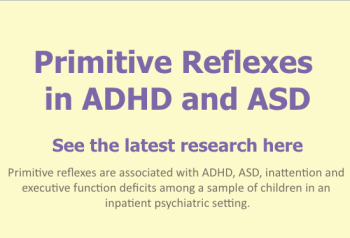Retained Primitive Reflexes in ADHD and ASD among Children in an Inpatient Psychiatric Setting
Research by Dr. Khiela Holmes, PhD, Pamela Handloser, OTR/L and Diane Hanley, OTR/L University of Arkansas for Medical Science, Psychiatric Research Institute, Little Rock, AR, June 2016.
Executive function abilities are higher-order cognitive functions that help to control behaviors and reach goals and also impact functional cognition. Executive function impairments are commonly seen in neurodevelopmental disorders such as Attention Deficit Hyperactivity Disorder (ADHD) and Autism Spectrum Disorder (ASD). One proposed way to better understand the underlying deficits is through retained primitive reflexes including the Asymmetrical Tonic Neck Reflex (ATNR), Symmetrical Tonic Neck Reflex (STNR), and Tonic Labyrinthine Reflex (TLR). These reflexes have been found to be associated with ADHD symptoms.
The purpose of the current study is to examine the degree to which reflexes are associated with ADHD and ASD among a sample of children in an inpatient psychiatric setting. Specific research questions are: 1) What is the most common reflex?; 2) Among the children diagnosed with ADHD and ASD, what is the most common reflex?; and 3) To what degree are reflexes associated with ADHD symptoms, ASD, and executive function deficits?
The current study employed a cross-sectional study design using information obtained during the routine course of clinical care. The sample (N = 196) has a mean age of 9.3 years and is 74% male, 74.5% White, 8.7% Black, and 10.7% biracial. The ATNR, STNR, and TLR were assessed during the occupational therapy (OT) evaluation by positioning the child, providing instructions, and assessing the severity of the retained reflex through clinical observations. Reflexes were determined to be absent, mild, moderate, or severe. ADHD symptoms and executive function deficits were assessed by the Conners’ 3 Parent Rating Scale. Descriptive, correlational, and multiple regression analyses were used to investigate the research questions.
Results demonstrated that 90.3% of the sample had at least one retained reflex present with the ATNR being most common (82.4%). Among the 55.6% of children diagnosed with ADHD, the most common reflex was the ATNR (81.5%). Among the 23.5% of children diagnosed with ASD, the most common reflex was also the ATNR (91.1%). Correlational analyses revealed that the ATNR was significantly positively associated with inattention (r = .15, p = .04), DSM-5 ADHD Inattentive symptoms (r = .18, p = .02), and executive function deficits (r = .18, p =.02). The STNR was significantly positively related to executive function deficits (r = .16, p = .05) and the DSM-5 ADHD Inattentive symptoms (r = .17, p = .03). Linear regression analyses revealed that a model including the ATNR, STNR, and TLR significantly predicted DSM-5 ADHD Inattentive symptoms and executive function deficits with the coefficient for the ATNR emerging as marginally significant.
Conclusions are that the ATNR is the most common retained reflex within this inpatient sample. The ATNR is also the most common among the children with ADHD and ASD. Retained reflexes, the ATNR and STNR specifically, are most significantly associated with inattention and executive function deficits with the ATNR emerging as a marginally significant predictor of executive function deficits. These findings are consistent with dissolution theory and could have implications for working with children with ADHD and ASD, especially those in inpatient psychiatric settings whose cognitive processes impair their daily routine. The current study offers an evidenced-based rationale for one element of current occupational therapy pediatric practice, the assessment and integration of primitive reflexes in children with concurrent diagnoses of ADHD or ASD. Data collected in this proposal can encourage OTs to focus more closely on this area in assessment, as well as to recommend more specific interventions to address reflex integration, in order to facilitate improved functional cognition.
The Asymmetrical Tonic Neck Reflex (ATNR) and Symmetrical Tonic Neck Reflex (STNR) are most significantly associated with inattention and executive function deficits among an inpatient psychiatric sample. There are implications for evidence-based OT assessments and treatment of children with ADHD or Autism.
Eylen, L. V., Boets, B., Steyaert, J., Wagemans, J., & Noens, I. (2015). Executive functioning in autism spectrum disorders: Influence of task and sample characteristics and relation to symptom severity. European Child and Adolescent Psychiatry, 24, 1399-1417. doi: 10.1007/s00787-015-0689-1
Faraone, S. V., & Bierderman, J. (1998). Neurobiology of Attention-Deficit Hyperactivity Disorder. Biological Psychiatry, 44(10), 951-958. doi: 10.1016/s0006-3223-98-00240-6
Konicarova, J., & Bob, P. (2013). Asymmetric tonic neck reflex and symptoms of attention deficit hyperactivity disorder in children. International Journal of Neuroscience, 123(11), 766-769. doi: 10.3109/00207454.2013.801471



